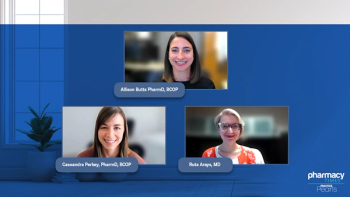
Monitoring PARP Inhibitors in Ovarian Cancer for Toxicities
Bhavesh Shah, RPh, BCOP, and Thomasina Morris, RPh, MHA, BCOP, discuss toxicities to monitor for when using PARP inhibitors to battle ovarian cancer.
Episodes in this series

Bhavesh Shah, RPh, BCOP: The major toxicities are hematologic, right? You have anemia, thrombocytopenia, and what am I blanking on?
Thomasina Morris, RPh, MHA, BCOP: Neutropenia.
Bhavesh Shah, RPh, BCOP: Neutropenia, exactly. You talked about the hypertension and the hematologic. Some of the others, like rash, are not as prominent as you would see with some of the TKIs [tyrosine kinase inhibitors]. How do you manage that in your practice?
Thomasina Morris, RPh, MHA, BCOP: We try to be as proactive as possible. If we don’t, then we’re not going to have the compliance with these patients who we hope to. It’s a lot of education. Toxicities tend to last up to 2 to 3 months. When patients get on medication, it’s very important for them to understand it’s not like chemotherapy, where you got the infusion, you were sick for 2 or 3 days, you feel better, and then you come back to us in 21 days. For patients with elevated blood pressure who manage it at home, we need to make sure they have a blood pressure cuff or a blood pressure diary. We also look at rash. I tell patients, when you’re at home, even after the first 2 or 3 doses, look in the mirror, look under your armpits, look in those areas that you wouldn’t normally think you would have a rash, have someone look at your back, because those are places you may miss. If they get hold of us and say, “I’m itchy, and sometimes the rash is just red,” we’ll call in a prescription or tell them to use something over the counter, like Benadryl [diphenhydramine] or hydrocortisone.
The other thing is when we’re talking about nausea, sometimes we go ahead and give patients prescriptions for 5HT3s, such as Zofran [ondansetron], or Reglan [metoclopramide]. In that case, when we know they may be taking it 2 times a day, they could take the Reglan up to 3 to 4 times a day and they can take it to settle their digestive system. Sometimes just taking the niraparib 1 time a day at bedtime might eliminate some of those nauseous effects. If they had really bad nausea during their treatment of paclitaxel-carboplatin, then we’re probably going to have to scale it up with either 1 or 2 antiemetics and possibly a scopolamine patch, so that we can keep them regimented as long as there were no issues with those patients maintaining the fact that they could still take their medication.
Taking it with or without food doesn’t seem to be an issue. But for the diarrhea and the constipation, we want to make sure they have Imodium [loperamide hydrochloride] or MiraLAX [polyethylene glycol] at home. We give them a basket of information to say, “This is what you’re going to use when you have symptoms. When you have these symptoms and they don’t resolve, we want to hear from you.” If you suddenly have these symptoms and you can say, “I can manage them,” then we’re good.
We were talking about the medications and the drug interactions. In our population, because it’s between 60 and 70 years old, we do have a lot of patients on medications. We also know that these patients must go to different providers in our system and get different treatments. It’s very hard to finally get med reconciliation to figure out these medications they’re on so that when we start a PARP inhibitor, we’re not going to cause an effect. How does your organization handle something like that as far as management of toxicities when it comes to drug-drug interactions?
Bhavesh Shah, RPh, BCOP: We forget that these drugs have not only hematologic but also these mild or low-grade GI [gastrointestinal] toxicities that could deter a patient from missing doses. We know that this is important for the minimum residual disease that they have; that’s why we’re giving it to them. It’s important to have a pharmacist or a nurse involved in their care in the first to essentially make sure that they’re taking their medication and they have the supportive care that they need.
We are pharmacists, so we can prescribe medications for supportive care. Essentially, the calls that we make on a frequent basis to the patient initially, as you said in the first 3 months, when we know that we anticipate these toxicities and have a closer outlook. COVID-19 did make it a little hard to have a lot of in-person visits, but we were having great telephone visit show rates during this time, and great information shows how many pills a patient has left and what else they started taking. Sometimes you have patients who come in, and they forget to bring their bottle of their new medication that they started, and they can’t tell you what it is. It changed the way we were managing patients. Sometimes we coordinated where they would touch base with their primary care provider to assess and get those tests done, like a CBC [complete blood count], and get their blood pressure assessed. Sometimes patients are not able to do their own blood pressure assessment because there are false readings.
Talking about blood pressure and going back to your patient population, hypertension is such a tricky adverse effect to manage when you’re dealing with that patient age group. Based on the JNC [Joint National Committee] recommendation, a lot of them are living at almost grade 3 hypertension. We need to make sure their blood pressure medications are adjusted before you start adjusting their PARP inhibitor.
We’re blessed with having primary care pharmacists within our models to manage this. Not a lot of folks have that type of collaboration. As you mentioned, a lot of pharmacist oversight and cross-collaboration with multiple stakeholders in keeping these patients on their therapies.
This transcript has been edited for clarity.
Newsletter
Stay informed on drug updates, treatment guidelines, and pharmacy practice trends—subscribe to Pharmacy Times for weekly clinical insights.





































































































































































































